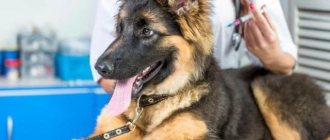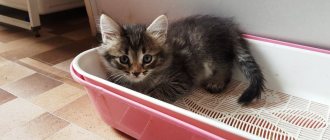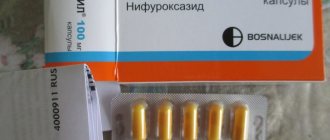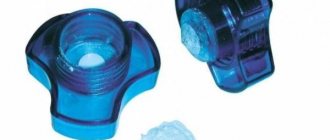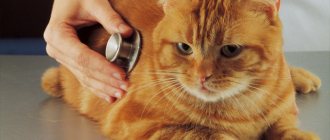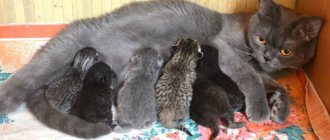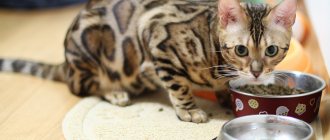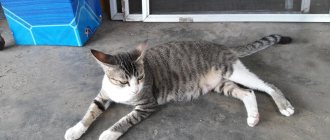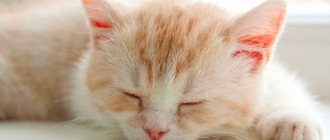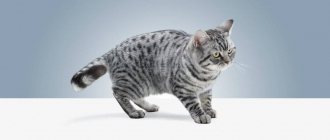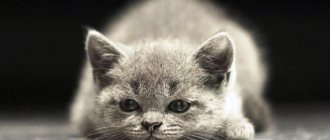Volvulus is a dangerous disease that can happen to any pet; cats are from him too
not insured. Since the disease develops rapidly and poses a serious threat to the life of the animal, it is necessary to be aware of how it progresses and what to do if a volvulus is suspected.
Diagnosis and treatment
If you notice signs of obstruction in your pet, take him to the doctor immediately. The veterinarian will examine the cat and palpate the stomach.
Often, if an obstruction is suspected, an x-ray using a contrast agent (barium sulfate) is prescribed.
This procedure in some cases helps to detect the presence of a foreign body, but not all objects are visible on an x-ray.
In addition to this examination, blood tests are prescribed to assess the general condition of the internal organs and identify concomitant diseases.
If none of the studies are successful, a laparotomy (an incision in the abdominal wall) is performed, during which surgeons examine the intestines for obstruction and remove it.
Treatment also includes the following:
- Administration of nutrient solutions intravenously (in case of severe intoxication or lack of appetite).
- Painkillers and medications that relieve inflammation.
- (if necessary).
- Infusion into the mouth.
- Removing the cause of the blockage surgically if taking the oil does not bring the desired result.
In case of intestinal obstruction, surgery is prescribed in most cases. After the procedure, your pet needs special care.
Actions of the owner in case of suspected bloat
If it is noticed that your pet has eaten some inedible object, or symptoms reminiscent of signs of bloat are observed, then you should immediately take the mustachioed creature to the veterinary clinic for an x-ray and examination.
What not to do:
- Offer your pet treats, let alone force feed her.
- Give the purr antiemetic drugs.
- Offering your cat drugs with a laxative effect can aggravate the problem and cause complete rupture of the intestine.
Caring for a sick cat
If a cat has undergone surgery, it is not given food for the first 24 hours. Water is given 12 hours after surgery.
It is necessary to regularly inspect the seams and treat them with chlorhexidine if they are inflamed. If the incision site is dry, no action is required.
They start feeding the pet within 24 hours; it is better to purchase a ready-made veterinary diet in the form of pates (Royal Canin Gasrto Intestinal, Hills I/D, etc.). The cat is given food in very small portions, but often - every 2-3 hours. The animal is transferred to its usual diet no earlier than 2 weeks after treatment. After surgery, further treatment can be done at home.
Recovery after illness
After surgery, the pet will be prescribed antibiotic therapy, as well as painkillers. All this has a detrimental effect on the animal’s microflora, so probiotics and a strict diet will most likely be prescribed to restore it.
In most cases, the pet will not be able to eat food on its own after such a serious operation.
After the mustache has gone home after surgery, it is extremely important for the owners to maintain sterility in everything while the animal recovers its strength. If at this moment any infection attaches to the animal, then most likely the pet will not be able to survive.
Preventing the disease at home
Prevention of atony is as follows:
- Monitor the amount of fluid your cat drinks (normally, the animal should drink 30-40 ml for every kg of weight).
- Do not allow your pet to play with small objects, and especially not with the New Year's rain.
- During the molting period, comb the animal more often, especially for fluffy cats.
Intestinal obstruction is a condition that requires immediate intervention. A complete blockage can be fatal in just 1-2 days, so at the first symptoms it is necessary to show the animal to a doctor.
An extremely acute and life-threatening condition that can befall any pet is volvulus in cats. You, as the owner, must understand that you cannot predict the danger, and help must be provided immediately. Forget about the statement: “This won’t happen to me” - read, 10 minutes will more than pay for itself if it helps save a life.
If you know the structure of the intestines, it will be easier to navigate. Meet for the first time? – we’ll try to figure it out. The entire esophagus is attached to the stomach by ligaments called the mesentery. The function of attachment is to maintain the anatomically correct location of the intestine and blood supply. During volvulus, the mesentery is twisted, as a result of which the main artery supplying the intestines with blood is pinched.
Note! Intestinal obstruction and volvulus are similar, but fundamentally different problems. The first occurs due to blockage of the intestinal slit and can cause circulatory problems, the second is guaranteed to deprive the intestines of blood and is accompanied by rapidly developing necrosis.
After the so-called overlap, a disruption of the intestinal blood circulation occurs; if the cranial artery is completely compressed, tissue necrosis (death) occurs in a matter of minutes. The condition is called ischemic necrosis, which affects the entire section, up to the colon. Next, peritonitis develops - inflammation of the peritoneum and.
Clinical picture: what happens during volvulus
What is volvulus, and how does it manifest itself?
The animal's esophagus is attached to the stomach with the help of ligaments, i.e., the mesentery. This is necessary for the correct location of the intestines and its blood supply. Intestinal volvulus provokes twisting of the mesentery, which compresses the main artery that supplies blood to the intestinal tissue. A cat can quickly die if there is a volvulus.
Volvulus of the colon and cecum is much less common. This process is called intussusception. With such a torsion, the affected area is much smaller, but this does not change the clinical picture of the disease. Only the duodenum is involved in volvulus of the small intestine. Both types of volvulus end with the immediate death of intestinal tissue and the death of the cat.
The disease always begins suddenly, is acute, and the cat’s condition deteriorates very quickly.
The main symptoms of volvulus are:
- vomiting with blood or bile;
- the abdomen becomes greatly enlarged and hardens;
- dehydration;
- severe pain in the abdominal cavity;
- constipation;
- shock caused by necrosis and blood loss;
- weight loss;
- vomiting feces;
- lethargy and apathy.
If the intestines are twisted several times, it is extremely difficult to save the animal. Death occurs within 1-2 hours.
Diagnosis of volvulus
All the owner can do is inject an anesthetic and quickly take the animal to the veterinarian after noticing the first signs of volvulus in the cat. The disease begins and proceeds with lightning speed, it is impossible to wait and eat enough that “it will go away on its own”!
Symptoms of volvulus develop in several waves:
- Weakness and apathy. Vomiting, often with blood. Pain and tension in the abdominal wall - the cat pulls its hind legs, the stomach is swollen, but not soft, as with gas formation.
- Shock state - intestinal tissues do not receive nutrition and oxygen (septic shock), the beginning of the necrotic process (hypovolemic shock).
- Dehydration and literally instant weight loss (shrinkage). In combination with severe vomiting, they can give a “blurred” picture for diagnosis.
- Frequent and unsuccessful urge to defecate most often indicates a volvulus of the colon.
The x-ray clearly shows distension of the small intestine. Liquid may be present in the cavities. With strong pressure - ruptures of the intestinal walls and internal organs. Confirmation of the diagnosis, as well as treatment, is possible only after surgical opening of the abdominal cavity. Unfortunately, in most cases, the owners do not have time to take the cat to the veterinarian or help is too late.
Volvulus is a rather dangerous phenomenon for both humans and animals. You should take immediate action if you see all the symptoms of volvulus. In cats and dogs, this problem should be correctly diagnosed, because, unlike humans, our pets cannot tell what hurts them and where. When intestinal volvulus occurs, you should react quickly and correctly recognize all clinical signs. The life of the animal largely depends on the speed of diagnosis and action. This problem leads to tissue death, a sharp deterioration in the cat’s condition, and disruption of the blood supply to the gastrointestinal tract.
Danger of disease
The following typical symptoms allow you to identify a dangerous disease:
- the animal begins to vomit with blood;
- Bile may also be present in the vomit;
- the cat experiences severe pain in the abdominal area, it instantly reacts to touching the abdominal cavity;
- there is constipation;
- dehydration of the pet’s body is also noticeable;
- the cat is losing a lot of weight, in appearance and behavior he is lethargic and apathetic;
- a cat that has developed an intestinal obstruction usually meows pitifully and even screams, as it is in terrible pain;
- at the most dangerous stages of the disease, the animal even vomits feces.
The main method used to save a cat is an operation, after which proper rehabilitation will be required. The owner will have to carefully care for him, feed him dietary food, and regularly show him to the doctor.
In some cases, the small intestine is twisted several times; this is the most dangerous situation, in which it is almost impossible to save your pet.
Unfortunately, bloat is a disease that is fatal in most cases. This is due to a violation of the blood supply to the large and small intestines, which is caused by compression of the main blood artery. Without blood, the cells die, and blood poisoning begins in the necrotic tissues, which results in the death of the cat.
But the most common bloat is not among cats, but among large breed dogs. Dog owners need to know this so as not to miss dangerous symptoms.
Causes of volvulus
The causes of intestinal volvulus are different. The most common problems veterinarians encounter are:
:
- poor nutrition;
- tumors and other common diseases of the gastrointestinal tract, as well as hernias;
- frequent constipation, which subsequently can lead to bloat;
- entry of foreign bodies first into the stomach and then into the intestines of the animal;
- increased activity after eating.
Lack of proper nutrition can lead to intestinal problems in the future. The animal’s diet should contain liquid food at least once a week: soup and broth. This does not mean that the diet of a cat or dog should be similar to the diet of a person, but the lack of liquid food can lead to frequent constipation (coprostasis) and ileus (intestinal obstruction).
Gastrointestinal diseases, tumors, hernias can become the root cause of intestinal dysfunction and, as a result, lead to bloat.
Foreign bodies that are not able to be digested (threads, New Year's rain, one's own wool), once in the stomach, and then in the intestines, become tangled and lead to constipation, obstruction, and entanglement of the intestines. Using laxatives at this time can further aggravate the situation and cause intestinal rupture.
Kittens and puppies that are active after eating are often susceptible to volvulus. Active behavior, running and jumping cause spasms in the intestines.
Other reasons can lead to bloat, but the above are the most common in veterinary practice.
What causes bloat?
The disease does not occur without reasons, knowledge of which allows cat owners to take effective preventive measures. What causes abdominal organs to twist?
- One of the reasons is poor nutrition, but the cat owner may not allow this.
- Volvulus can also occur due to tumors and various gastrointestinal diseases.
- A risk factor is hormonal disorders, which are associated with weakening of the ligaments (mesenteries).
- The risk of illness may arise from increased activity after feeding.
- If your cat is constantly constipated, she may experience volvulus.
- Obstruction may be due to foreign objects entering the intestines. If the owner notices that the cat has swallowed a foreign body, he should immediately take it to the hospital.
Diagnostics
The first noticeable factor indicating that a cat has a volvulus will be vomiting. It is observed in almost 99% of cases. Accompanied by bloody discharge or small blood spots. In parallel with vomiting, the cat becomes nervous and can sometimes even show aggression, which is caused by severe pain. The animal cannot stop eating or drinking.
Severe abdominal pain is manifested by a plaintive meow, or even a cry. In addition, the cat's belly becomes inflated and hard to the touch. Bloating is accompanied by intestinal flatulence, which significantly increases pain. When you touch the stomach, the cat may show aggression and bite.
During this period, the animal cannot go to the toilet normally due to severe pain. Gradually, the body becomes exhausted and dehydration occurs. At the same time, exhaustion of the body can occur within several days. But, before this, the cat may die from painful shock in the absence of quickly provided first aid.
All of the above clinical signs are the first ones you should pay attention to in order to diagnose volvulus. To 100% establish the cause, you should take a picture (x-ray) or ultrasound diagnostics of the abdominal cavity. The veterinarian will immediately see distension of the small intestine or duodenum with the possible presence of fluid in the cavity. In addition, the cat may have a torsion of the rectum (cecum and colon).
Constipation
If there is no stool for several days, we can talk about constipation. An adult pet, on average, visits the litter box once a day for “big business.” If there is no bowel movement, then the cat has intestinal problems. Analyze what he ate and drank. Problems with stool can be external or internal. The first depends on the diet and the characteristics of the content.
We invite you to read: Vikasol for cats description and methods of use
Intestinal hypotension in a cat can also cause a lack of stool. Muscles lose firmness and elasticity. The ability to contract is greatly reduced. There are problems with the toilet. There is no stool for 3-4 days, there is an admixture of mucus and blood. Sometimes the cat stays in the tray for a long time, the process of defecation brings pain. The pet can leave the toilet and return to it again. Strong stress of unsuccessful attempts can cause vomiting.
First aid
After the first, acute signs of the disease appear, a number of measures should be taken that will alleviate the animal’s condition, although they will not solve the problem as a whole.
First aid measures
:
- If possible, give an anesthetic injection. This will reduce pain. Protects the animal from painful shock. Painkillers should not be given in tablet form (orally).
- Place the cat on a towel or rag, as he will vomit frequently. After this, try not to disturb the animal, but give it peace.
- Do not feed the cat under any circumstances, since volvulus is characterized by intestinal obstruction and eating food can only aggravate the condition.
- You can place a saucer of water next to it so that the animal can drink water.
- Try to take him to the vet as soon as possible. The sooner the doctor begins treatment of the disease and performs surgery, the faster it will be possible to relieve the cat’s pain and get rid of the disease.
Professional help
With intussusception, X-ray images show a clear picture of stretching of the small intestine. There may be liquid in the cavities. A specialist will not be able to tell the owners for sure that the pet has bloat; only surgery will give an accurate answer. Unfortunately, many mustachioed creatures die before they can reach the clinic with their owners.
If the pet was successfully delivered, then the animal will undergo surgery at the veterinary clinic - this is the only way to rid it of the problem.
If the lesion has affected most of the tissues, then complete removal of the small intestine is possible; in this case, the mustachioed creature will need maximum care, since it will need to be constantly taken to courses of maintenance therapy and its nutrition will be strictly monitored for the rest of its life.
Treatment
Intestinal volvulus is a problem that can be solved, in most cases, surgically. And the sooner the operation is performed, the higher the chances of recovery. After diagnosing the exact location of the bloat, the veterinarian chooses a method of elimination. If necrosis has affected a minimum of intestinal tissue, the doctor cuts out the affected area and places the twisted section in the correct anatomical position. In the simplest cases, the veterinarian just needs to position the intestines correctly, removing any knots that have appeared.
Depending on the complexity of the injuries caused, it depends on how difficult the operation will be, as well as the postoperative recovery period.
Postoperative care and rehabilitation
Treatment of intestinal volvulus in a cat through surgery cannot be done without consequences. But, if everything is done correctly, the animal will quickly recover. After the operation, the following conditions must be met
:
- provide rest for the animal;
- take medications prescribed by your doctor to heal the wound and restore intestinal functions;
- follow a strict diet (especially in the first weeks after surgery);
- monitor changes in the animal’s condition;
- keep the apartment clean and disinfect.
Often, after surgery, the cat cannot feed on his own, so he will have to be given food through a catheter for some time. A catheter is inserted into the abdominal cavity and liquid food is administered through it.
The intestines are a very important part of the body and problems with them are always fraught with pain and risk of infection for the animal. No one is immune from volvulus, but still, if such a misfortune occurs with your pet, then the main thing is to correctly diagnose the cause and take all necessary treatment measures as soon as possible.
In cats, intestinal obstruction is a condition in which the movement of food through the intestines is partially or completely impaired. This pathology is not an independent disease; This is a syndrome that is quite common and equally dangerous for small kittens and adult cats.
Features of postoperative rehabilitation
The course of therapy prescribed after volvulus surgery includes taking antibiotics and probiotics. It is important to follow a strict diet, because the digestive system has been affected.
After removal of part of the intestine in the abdominal cavity, the animal will not be able to feed itself for a long time. The veterinarian installs a catheter through which liquid food is supplied.
The catheter can be inserted directly into the abdominal cavity or through the nose and throat. In such a state, weakened by illness or surgery, the pet really needs attention, kindness, and care. If the catheter is installed in the cavity, a small hole is cut in it, and a fixing dilator is installed. Food goes directly into the intestines, bypassing the esophagus.
Reasons and typology
Difficulty or cessation of the passage of food can be caused by a violation of motor function, in particular paralysis, or mechanical function of the intestines.
Mechanical intestinal obstruction in cats can be caused by a variety of factors:
- blockage of the intestines by a foreign object is the most common cause, since cats are prone to swallowing small household items (threads, needles, rags, toys, their own fur, etc.);
- neoplasms in the abdominal cavity, or directly in the intestinal wall itself;
- volvulus or torsion of the intestine;
- intussusception (that is, a condition in which one part of the intestine turns inside another part);
- hernias;
- abscesses or granulomas;
- adhesive disease;
- congenital anomalies, in particular intestinal diverticulum.
How dangerous is the disease?
Intestinal volvulus is a pathological process in which the mesenteries or gastric ligaments are twisted, which leads to pinching of the main artery that supplies the intestines with blood. Thus, the anatomical location of the intestine and its blood supply are disrupted. The supply of nutrients to the organs and the process of fluid absorption stops, so the sick pet is in serious danger if therapy is not started.
There may be cases when one part of the intestine is screwed into the lumen of another - this also leads to obstruction, but is called intussusception.
Both with volvulus and intussusception, professional help is needed; you cannot cope with this on your own.
Volvulus is an extremely dangerous and rapidly developing disease. The twisted intestine not only compresses the main blood artery, which supplies blood to all parts of the large and small intestine, but also disrupts its correct anatomical location. Compression of blood vessels provokes rapid death of cells in intestinal tissues, which leads to ischemic necrosis, blood poisoning and death of the animal. By the way, most often volvulus is observed not in cats, but in large breed dogs.
When intestinal volvulus occurs, intestinal cells die.
Symptoms of intestinal obstruction in cats
With partial obstruction, only part of the intestinal contents penetrates through the obstruction, and with complete obstruction, the movement of feed masses stops. Therefore, one of the symptoms is a small amount of feces or their complete absence. In both cases, in the area of the intestine where the blockage occurred, blood circulation is disrupted, which can lead to necrosis, that is, death of part of the intestine. Complete obstruction is characterized by severe clinical manifestations such as sudden onset of vomiting, depression, anorexia, abdominal pain and collapse. This condition is life-threatening for the animal and urgent surgical intervention is required.
The general condition of the cat depends on the degree of obstruction (low, medium, high), the size of the foreign body and the duration of the disease.
The following are the main symptoms of intestinal obstruction in cats:
- decreased appetite, sometimes reaching the point of complete refusal of food;
- periodic vomiting that occurs in most cases;
- reduction in the amount of feces or their complete absence;
- pain and increased abdominal volume;
- deterioration of general condition.
Dehydration of the body is also noted as a result of impaired water absorption and an imbalance of intestinal microflora. With prolonged fasting, exhaustion may occur, and as a result, the overall body temperature decreases (less than 37? C), general weakness occurs, and shortness of breath may occur. If help is not provided to a cat in this condition, this may result in the death of the animal.
Therefore, if the above clinical signs occur, you should immediately contact a qualified veterinarian at a veterinary clinic.
It should also be understood that each case is individual, and not all cats have pronounced symptoms. In some animals, intestinal obstruction may manifest itself with only a few of the signs listed above, so you should be attentive to your pets and pay special attention to even subtle changes in their condition.
Symptoms
The fundamental sign of intussusception is vomiting. At the same time, the animal makes it clear with its plaintive meows that it is in extreme pain. Other manifestations that will let the pet owner know that the animal should be taken to the veterinary clinic immediately are:
- Sudden changes in behavior - the patient's apathy and dejection, or vice versa, the mustache's constant running from place to place as a way to attract attention to itself.
- Refusal of treats, because the mustache understands that with food it will become even worse.
- The urge to vomit or the immediate appearance of vomit (often interspersed with blood).
- A sick mustache does not allow him to touch his tummy (it becomes hard and inflated) - this gives him acute pain.
- Gases accumulate in the cat's body, so the mustache may begin to roll on the floor, trying to free itself from them.
- The patient does not defecate - the absence of feces in the tray for a long time can be both a sign of constipation and obstruction. But if in the first case, the cat can still sometimes go to the toilet, then with volvulus in cats, in addition to the listed symptoms, there is a complete absence of bowel movements (surgical intervention is necessary).
- Shock state - nutrients and oxygen do not reach the intestines, this situation leads to hypovolemic shock.
- The patient's body becomes dehydrated and therefore the mustache literally dries out before our eyes (its body weight decreases).
READ Ideas for naming a British cat: the best nicknames for boys and girls
Volvulus in a cat has a variety of symptoms, which are especially pronounced if the small intestine is involved in the process. The animal begins to suffer from acute cramping pain. It cannot tell the owner about them, but makes it clear that it is uncomfortable. It worries, pays attention to the stomach, tries to lie down and curl up into a ball.
- bloating and asymmetry of various parts of the abdomen;
- increasing vomiting of eaten food;
- dehydration of the body, “drying out” of the body;
- a significant increase in general temperature;
- lack of stool for several days;
- increasing weakness, pallor of the mucous membranes;
- shock and loss of consciousness.
Volvulus of any part of the large intestine is less common and is characterized by more mild symptoms. But in any case, if the patient is not provided with medical assistance in a timely manner, the outcome of the disease will be unfavorable.
Diagnosis of intestinal obstruction in cats
At the clinic, you should tell the doctor in detail about all the changes you notice in the cat’s condition. The specialist will carefully examine the animal; it may be necessary to take blood and urine tests to assess the condition at the time of treatment and rule out poisoning and infectious complications. Taking into account the general condition of the cat, the doctor prescribes a treatment regimen.
Most likely, a plain radiograph of the animal's abdominal cavity will be required. Intestinal ultrasound in this situation is not very informative, but sometimes you can see indirect signs of a foreign object, as well as evaluate peristalsis.
Fig.1. Wire in a cat's rectum
Plain radiography often does not provide enough information to make a diagnosis (unless the animal has a radiopaque foreign body), but it helps determine what part of the gastrointestinal tract is affected.
It should be remembered that not all objects can be seen on an x-ray. Needles, paper clips, stones, glass, and so on are radiopaque. But plastic, rubber, threads and other similar objects can only be detected with the help of an X-ray contrast agent. In this case, the cat is fed a contrast agent and a series of photographs are taken to track its passage through the digestive tract at 15 minutes, 30 minutes, 2 hours, 6 hours after the administration of the contrast agent, and then at the discretion of the veterinarian.
Rice. 2. Silk ribbon in the small intestine of a cat.
But palpation and radiography of the abdominal cavity usually make it possible to make a presumptive diagnosis and provide grounds for diagnostic surgery. This can be diagnostic laparotomy, laparoscopy, fibrogastroduodenoscopy (FGDS), during these studies the doctor conducts a more detailed examination of the organs of the digestive system.
Treatment of intestinal obstruction in cats
As a result of establishing the cause, further actions can be judged: either conservative therapeutic treatment of the sick animal is carried out, or emergency surgery is performed to eliminate the cause of blockage of the intestinal lumen (if a foreign body, hernia, tumor, etc. is detected).
Surgery is also necessary if symptoms persist or worsen, or if signs of peritonitis are noted.
In all cases, special attention should be paid to stabilizing the animal and restoring fluid and electrolyte balance after surgery.
Risk group
The most susceptible to this dangerous disease are small kittens and young cats under one year of age. More often, they suffer from volvulus of the ileum and cecum. For adult animals, a typical cause of volvulus is the entry of foreign objects into the esophagus or the formation of malignant tumors.
Intestinal obstruction is sometimes called intussusception. This is a dangerous condition that often ends in death if measures are not taken in time. The problem occurs in both small kittens and adult animals.
READ Review of the best vitamins for kittens and cats with calcium; preparations for the immunity of pregnant women and the elderly, against hair loss Hokamix, Beaphar
This also includes pets who have tumors in the intestines or congenital anomalies, such as diverticulum.
Often intestinal obstruction is caused by ordinary New Year's rain
Here are the main reasons for the development of the disease in a cat:
- Blockage of the esophagus by a foreign body - up to 80% of cases. This may be the result of a cat swallowing a candy wrapper, small toy, thread, New Year's rain, etc. In rare cases, this condition can be caused by hairballs, this applies to long-haired pets who constantly groom themselves.
- Constipation. In this case, against the background of digestive disorders, solid feces accumulate in the animal’s intestines and cannot pass out on their own.
- Presence of parasites in the intestines. In case of helminthic infestation, the animal is given anthelmintic drugs. As a result, the parasites die and are sent to the small intestine, where they form a large lump, resulting in an obstruction.
- Volvulus. This condition develops rapidly. The intestines become twisted, acute blockage develops, and tissue begins to die. Without medical help, the animal dies within 24 hours.
- Presence of tumors in the intestines. Volvulus can be caused by a malignant or benign tumor that has formed on the wall of the small intestine.
- Congenital anomalies or chronic diseases (diverticulum, presence of adhesions, etc.).
There are many reasons for the development of obstruction; this condition requires immediate intervention by a surgeon, otherwise the animal may die within 1-2 days.
What to do if you suspect intestinal obstruction in a cat
If you notice symptoms of intestinal obstruction in your pet or suspect that the cat may have swallowed any foreign objects, immediately seek help from a veterinary clinic!
Do not force feed or water your cat, as this may cause vomiting. You should not give antiemetic drugs that do not have a therapeutic effect. Laxatives and drugs that enhance intestinal motility may in some cases be contraindicated, since their action can lead to intestinal rupture.
Clinical signs may not always be clear, so you need to contact a qualified specialist at the clinic as soon as possible, since the clinic has all the necessary equipment for a speedy diagnosis.
Vaseline oil
Dry feces in small quantities indicate impaired peristalsis. The longer waste products are not removed from the body, the stronger the intoxication. In the absence of bowel movements, it is recommended to use Vaseline oil. This is an emergency measure that should not be abused. Experts usually prescribe 5-10 ml per dose.
We suggest you read: Is teeth cleaning necessary for cats and how to care for the oral cavity of pets
There are many manufacturers
The result should appear in 4-5 hours. If bowel movement does not occur, you can give 5 ml again. The maximum dose for an adult is 20 ml per day. To give Vaseline oil to a cat, use a regular syringe without a needle. Administer orally strictly at the root of the tongue. Otherwise, the purr may spit it out. The drug is addictive, so use only as a last resort and after consultation with a specialist.
Sometimes owners do not go to the clinic and try to alleviate the suffering on their own. You should consult your veterinarian about how to cleanse your cat’s intestines. It will also eliminate serious problems for which laxatives should not be given.
Intestinal obstruction in cats
There is a complete or partial cessation of fecal movement. Caused by two factors:
- ingestion of a foreign body that is not digested,
- tumors, volvulus or penetration of one intestine into another, hernia.
Such conditions are dangerous. Vomiting is typical, with it a large amount of moisture and nutrients are lost. Attempts to get him drunk do not bring results. They only provoke the process even more. If assistance is not provided, death can occur within 2-5 days. The closer to the stomach the blockage occurs, the more severe the illness. There is no need to give antiemetic drugs. They only mask the disease and have no therapeutic effect.
Clinical case of treatment of intestinal obstruction in a cat
The cat Izyum was admitted to the Pride Veterinary Center with complaints of repeated vomiting with blood and refusal to feed for three days.
On examination by veterinary therapist A.M. Vasilyeva. a thread was identified under the tongue. After X-ray diagnostics with contrast, a diagnosis of intestinal obstruction was made. Surgeon A.K. Mamedkuliev Surgery was performed and the thread was completely removed.
At the moment, Izyum’s condition is excellent, he is undergoing treatment at home.

